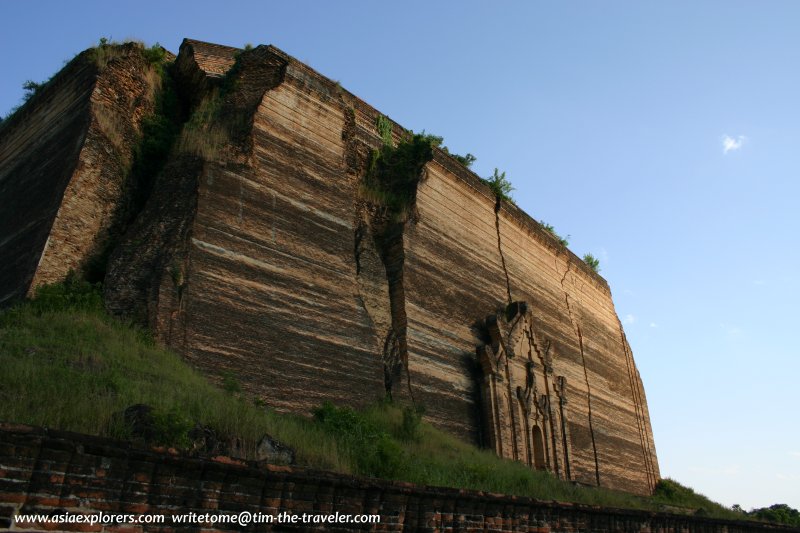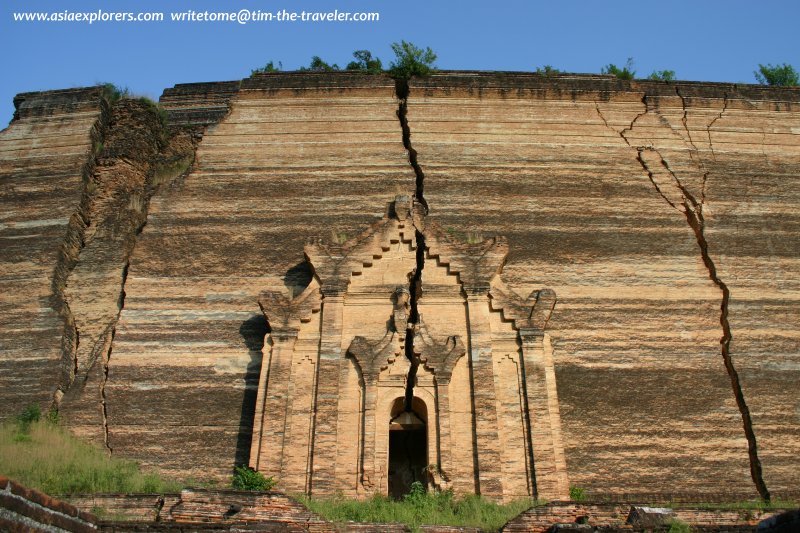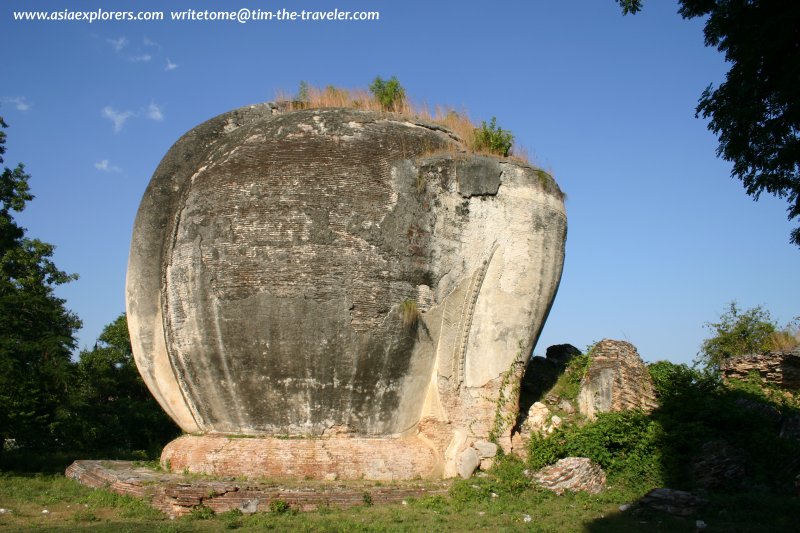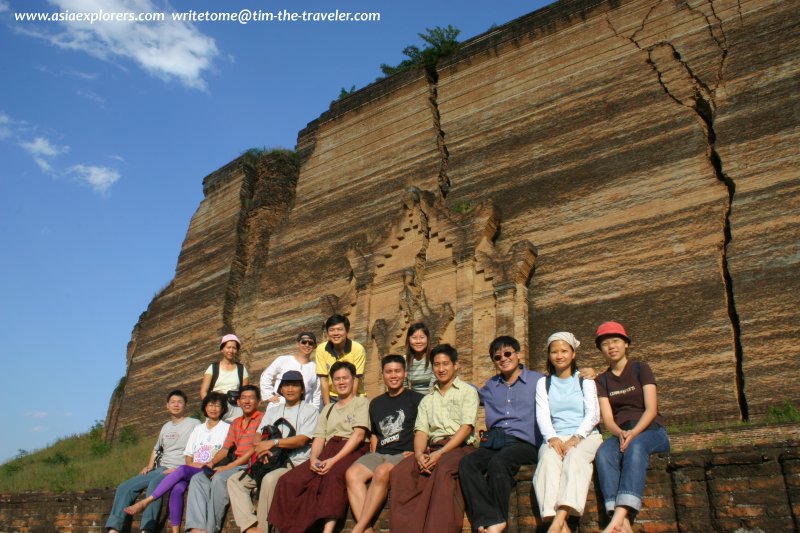 Mingun Pagoda (23 November 2003)
Mingun Pagoda (23 November 2003)
The Mantara Gyi Pagoda, also called the Mingun Pahtotawgyi or the Mingun Pagoda, is a massive unfinished stupa in Mingun. It stands 100m (330 ft) tall. The Mantara Gyi was intended to tower 500 ft tall, making it the tallest zedi in the world. Instead, it now earned the dubious title as the "world's largest pile of bricks". At the very least, I describe it as a monument to a lofty ego that could not be supported by the technology of its period.
I visited the Mantara Gyi with a group of AsiaExplorers members when we were sights in the vicinity of Mandalay. The Mantara Gyi is located in the village (or should I call it town) of Mingun, across the Ayeyarwady River. the Mantara Gyi was built between 1790 and 1797 by King Bodawpaya, the fourth son of King Alaungpaya, founder of the Konbaung dynasty. He is ruler of Tanintharyi (Tenasserim), the Mon lands and Rakhaing as well as much of Central Myanmar. He had just succeeded in obtaining the Mahamuni Buddha (refer to the Maha Myat Muni Paya, which he brought from Rakhaing to Amarapura, and had also become the proud owner of a white elephant. He was at the peak of his power, and wanted to advertise it by embarking on this mega project.
 Mingun Pagoda Earthquake Crack (23 November 2003)
Mingun Pagoda Earthquake Crack (23 November 2003)
In 1790 a visiting Chinese delegation presented to King Bodawpaya gifts which included a tooth relic of the Buddha, and three of the Chinese emperor's daughters as wives. King Bodawpaya were delighted with the gifts, especially the tooth relic, for both King Anawrahta nor King Alaungpaya had coveted but neither had succeeded in getting.
The Mantara Gyi Pagoda was intended to house the tooth relic. A structure worthy to house such a sacred relic must be of colossal dimensions, so the Mantara Gyi was to reach a full height of 152 m (500 ft). To supervise this project, King Bodawpaya moved his residence to an island on the Ayeyarwady, and left the running of the country in the hands of his son the Crown Prince. Thousands of slaves and prisoners of war, mostly from his newly conquered territory of Rakhaing, were put to forced labour to build the pagoda.
 Lion of Mingun Pagoda (23 November 2003)
Lion of Mingun Pagoda (23 November 2003)
To enhance safety, layers of brickwork were used internally instead of scaffolding. To ensure that the brickwork is symmetrical and smooth, a central pillar measuring 44 feet in circumference was erected to serve as a reference point. According to archaeologist, he world's first use of a piling system was employed at the pagoda. Nevertheless after 10 years of construction, only 162 feet of the structure was built. It was just too immense and ran into severe problems.
Simultaneous to the Mantara Gyi Pagoda, King Bodawpaya was recommencing work on the stalled Mektila Dam project, for which he imported several thousand more workers from outside. To keep these huge labour force in check, he deployed a large army to supervise the construction.
Many of the slaves and prisoners of war, unable to tolerate this great oppression, soon escaped to neighbouring Bengal, which was under British rule. From there they launched guerrila warfare against the Burmese troops. This was to explode into the First Anglo-Burmese War.
 Mingun Pagoda, also called Mantara Gyi Pagoda (23 November 2003)
Mingun Pagoda, also called Mantara Gyi Pagoda (23 November 2003)
Insufficient labour was plaguing the pagoda project. Also there was a superstition circulating in the country that when the pagoda is finished, the country would be in ruin. King Bodawpaya brushed aside the superstition, convinced that his destiny was to be a future Buddha. When the pagoda's shrine room was completed, he packed it with all the treasures he could get his hands on, including 1500 gold figurines, 2434 silver ones, and nearly 37,000 objects, including a soda-water machine just invented in England. And then, the room was sealed.
By the turn of the 19th century, the economy of the country was at the verge of collapse, and that finally compelled the king to stop work on the pagoda. He died in 1819, at the age of 75, after a rule of 38 years, making him the longest-reigning monarch of the Konbaung dynasty. He left 122 children and 208 grandchildren, but none share his keeness for the pagoda project, hence it was never revived.
Massive earthquake in 1838 and 1956 caused the upper sections to collapse into the hollow shrine room, and introduced gaping cracks on the surface. Nevertheless the base still towers 50 m tall. Two colossal guardian lions, the chinthes, guard the unfinished pagoda facing the river. They tower 95 feet high.
 Latest updates on Penang Travel Tips
Latest updates on Penang Travel Tips
 Map of Roads in Penang
Map of Roads in Penang
Looking for information on Penang? Use this Map of Roads in Penang to zoom in on information about Penang, brought to you road by road.
Copyright © 2003-2025 Timothy Tye. All Rights Reserved.

 Go Back
Go Back